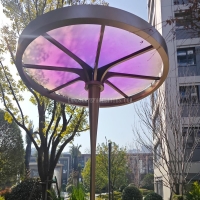Welcome to the website for landscape facilities products and knowledge.
How can a landscape bar counter be designed to create a sense of movement or flow in the outdoor space?
Designing a landscape bar counter that generates a sense of movement requires thoughtful integration of form, materials, and spatial dynamics. The key lies in manipulating visual cues and physical elements to guide the eye and create rhythm throughout the outdoor space.
Curved configurations naturally suggest motion better than angular designs. A sinuous, organic bar shape that meanders through the landscape immediately establishes flow. Consider incorporating multiple levels or tiered sections that gradually step down or up, creating visual progression. The choice of materials significantly contributes to kinetic perception. Using linear stone or wood slats arranged in directional patterns can create strong visual vectors that pull the eye along the counter's length. Composite materials with subtle color gradations or textured surfaces that change appearance from different angles add dynamic quality.
Integrating water features represents one of the most effective movement strategies. A narrow channel of water flowing along the bar's edge or cascading down a textured surface provides actual motion and auditory movement cues. Strategic lighting enhances the perception of flow even after dark. LED strips installed beneath counter overhangs or positioned to graze textured surfaces create dramatic shadows and highlights that change with perspective. Directional spotlights can emphasize the bar's sweeping lines, while programmable colored lights can create actual movement through sequential illumination.
The surrounding landscape should complement and extend the bar's dynamic qualities. Planting schemes with grasses that sway in breeze or arranging pavers in sweeping patterns that radiate from the bar help integrate the structure into a cohesive flowing environment. The bar counter should feel like a natural element within a larger kinetic system rather than a static object placed in the landscape.
Functional elements can further reinforce movement principles. An integrated serving track that allows bartenders to slide drinks along the counter or circular seating arrangements that encourage circulation around the bar add physical motion to the visual experience. The height transition between preparation areas and serving surfaces can be designed as a continuous wave rather than abrupt level changes.
Ultimately, successful movement-oriented design creates an engaging experience where the bar counter becomes a dynamic focal point that organizes and animates the entire outdoor space through implied and actual motion, transforming stationary entertainment areas into vibrant, flowing environments.
Related search:

Recommendation
Metal frame with gradient color acrylic combined with high-end shading landscape facilities